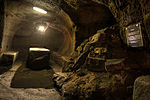The Drum, Edinburgh
Category A listed buildings in EdinburghCountry houses in EdinburghHouses completed in 1585Inventory of Gardens and Designed LandscapesUse British English from October 2017 ... and 1 more
William Adam buildings

The Drum is an 18th-century country house and estate on the outskirts of Edinburgh, Scotland. Located between the Gilmerton and Danderhall areas, The Drum is 4 miles (6.4 km) south-east of the city centre. The Drum was the seat of the Lords Somerville from the later Middle Ages, who built a 16th-century house on the estate. This was replaced in the 1720s with a classical house by William Adam. Sold by Lord Somerville in the early 19th century, the house remains in private hands.
Excerpt from the Wikipedia article The Drum, Edinburgh (License: CC BY-SA 3.0, Authors, Images).The Drum, Edinburgh
Edwards Wynd, City of Edinburgh Gilmerton/Inch
Geographical coordinates (GPS) Address Nearby Places Show on map
Geographical coordinates (GPS)
| Latitude | Longitude |
|---|---|
| N 55.9084 ° | E -3.1201 ° |
Address
Drum House
Edwards Wynd
EH17 8XW City of Edinburgh, Gilmerton/Inch
Scotland, United Kingdom
Open on Google Maps







